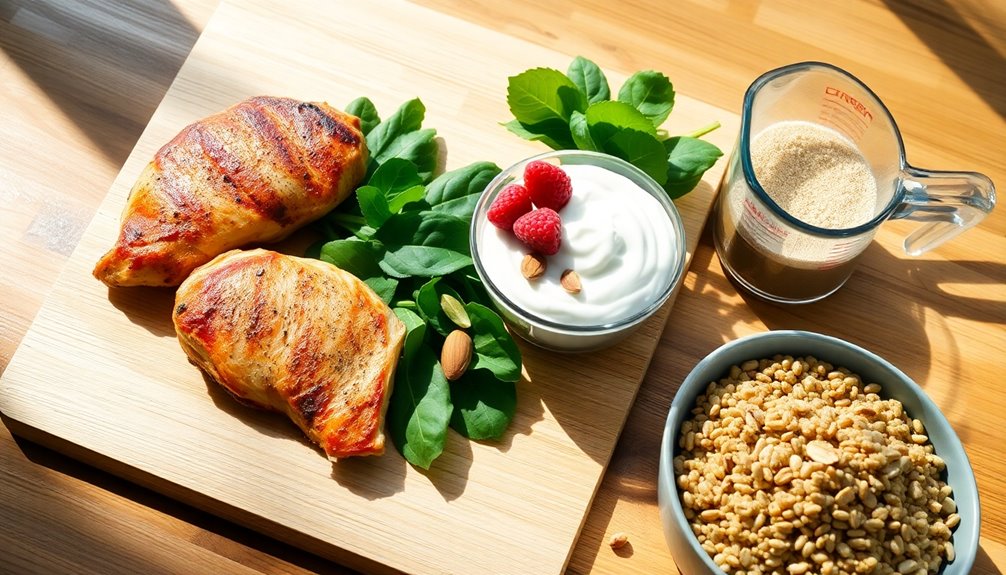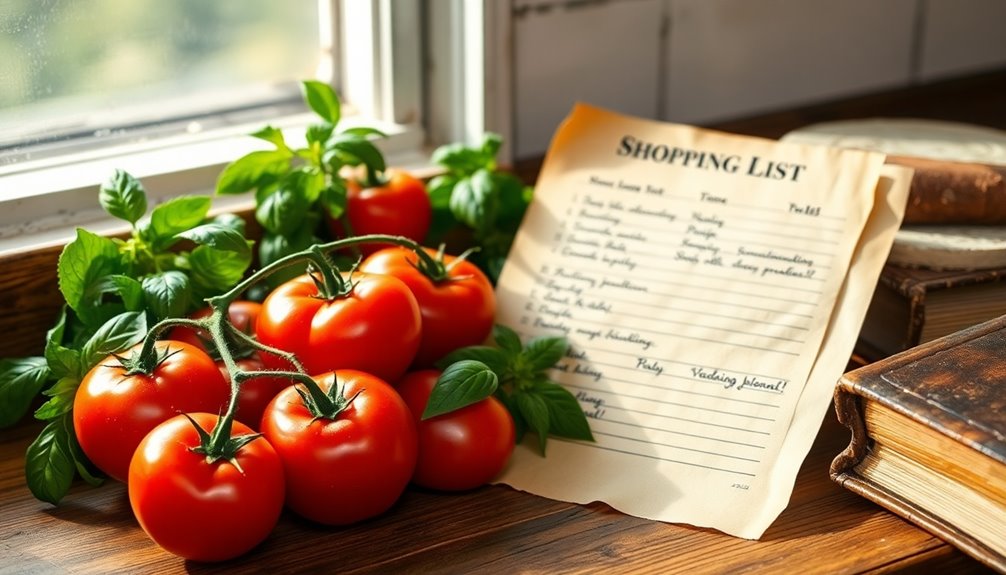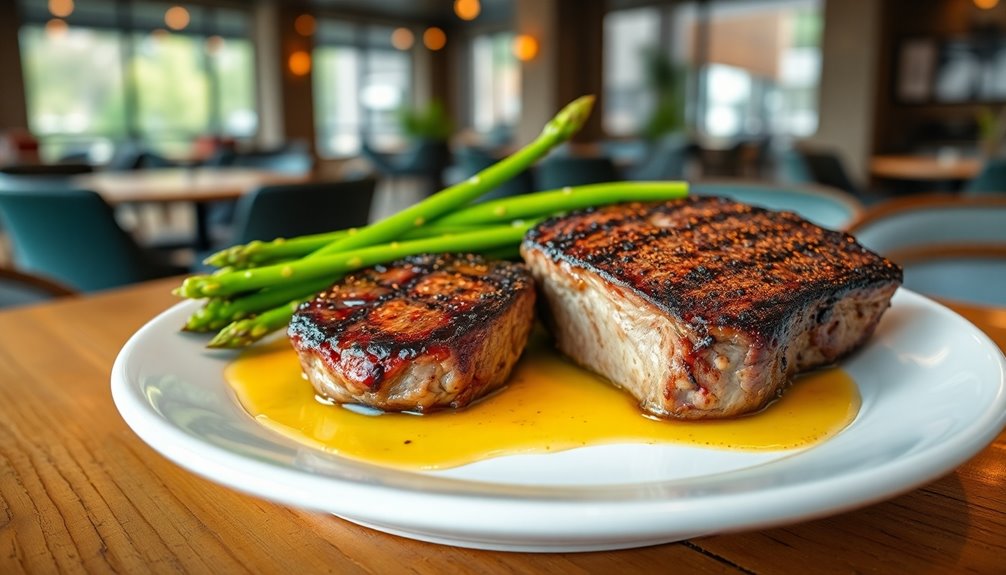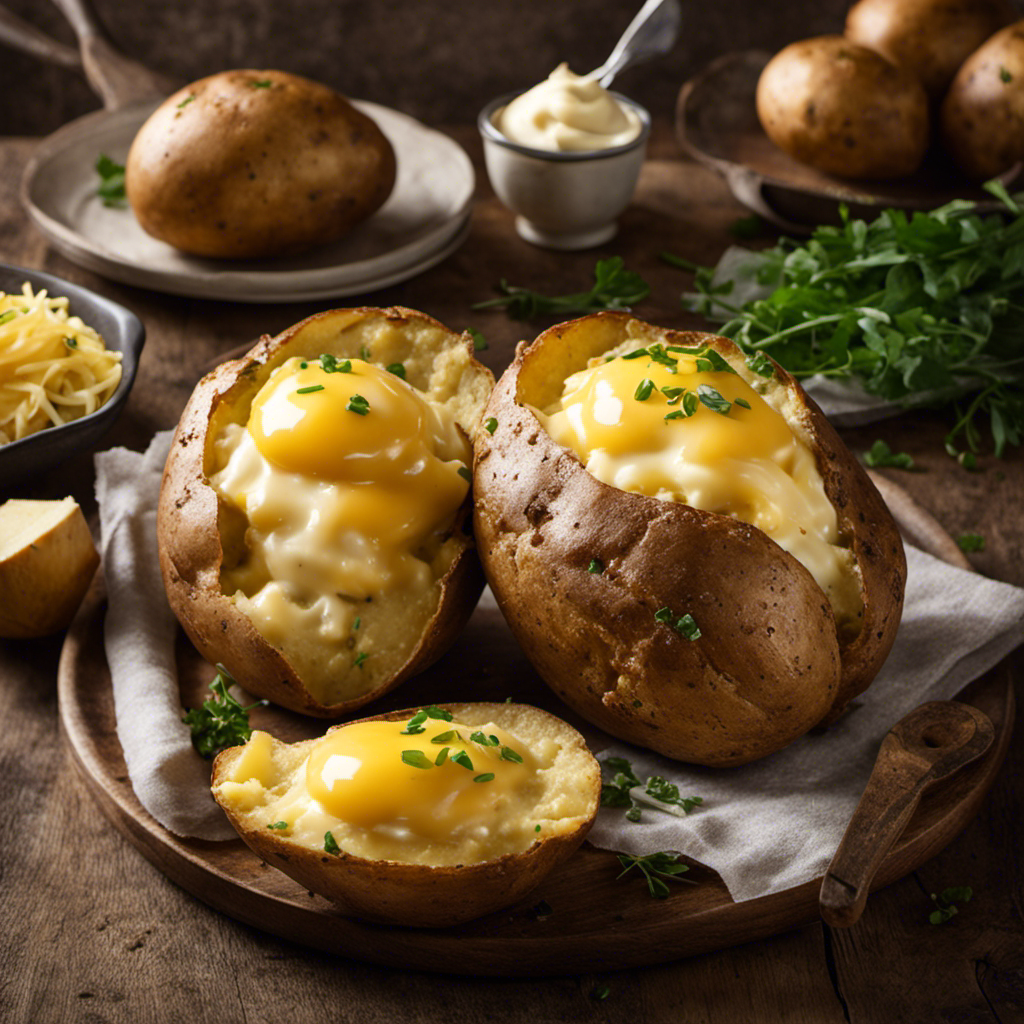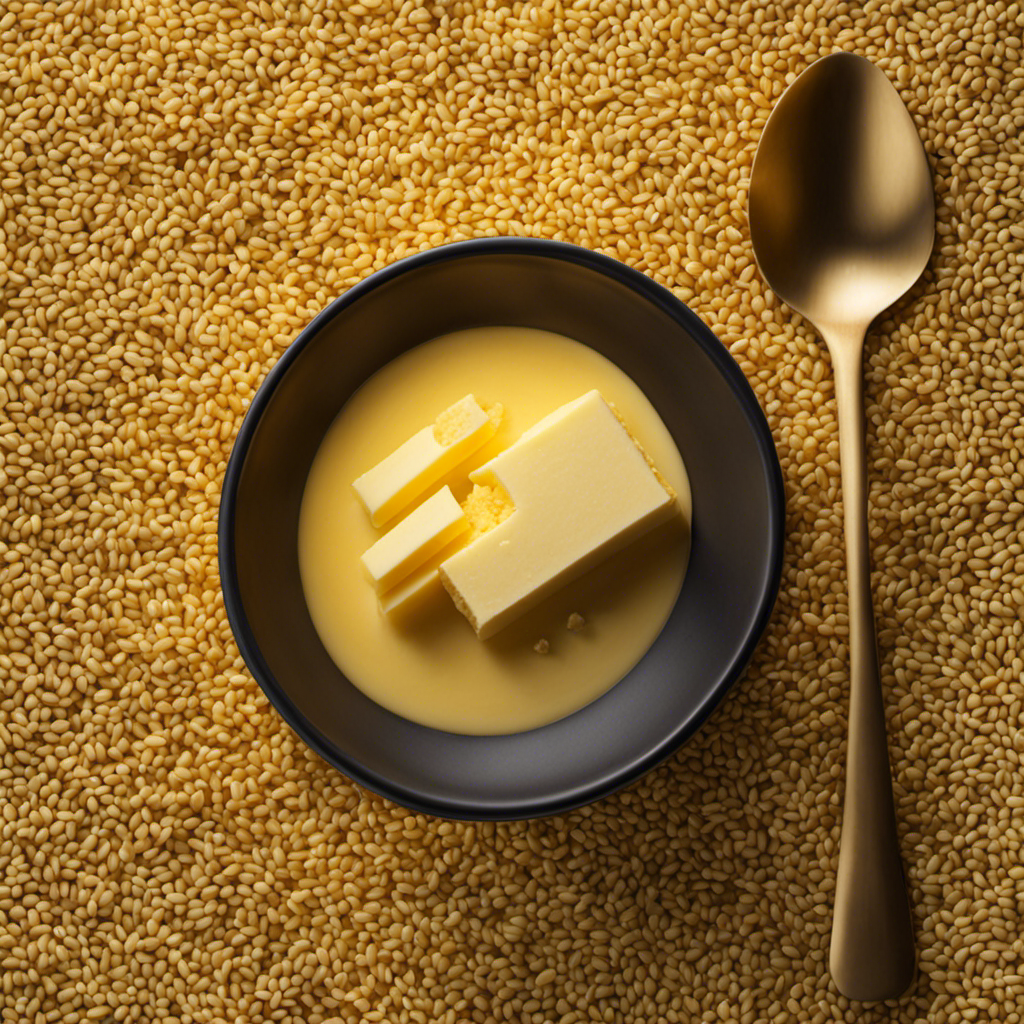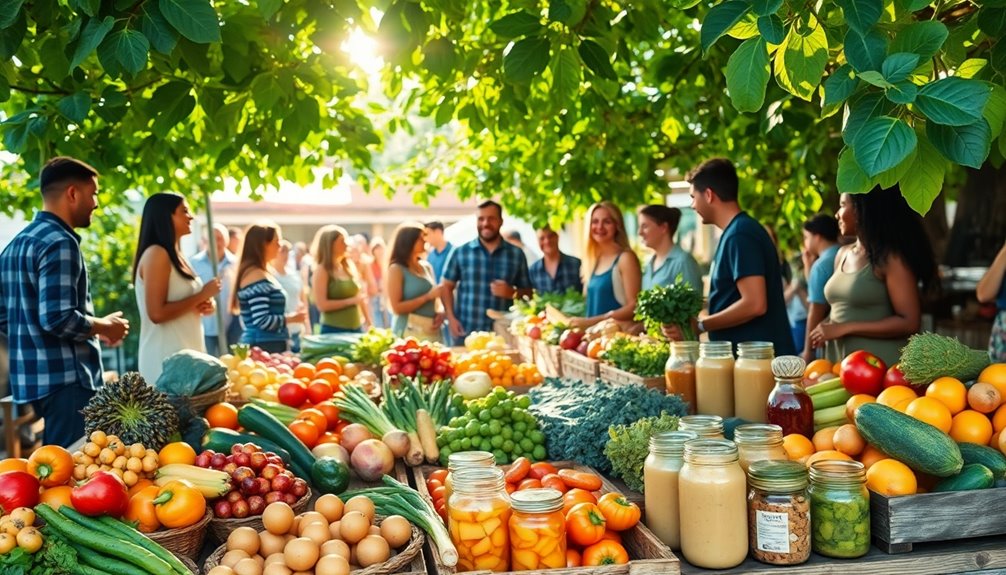To visualize 180 grams of protein, think of three grilled chicken breasts, totaling about 153 grams, paired with a cup of Greek yogurt for an extra 20 grams. You could also opt for two cans of tuna, which provides 50 grams, along with a serving of whey protein for 25 grams. For some variety, a quinoa and black bean bowl adds another 20 grams. Combining these options can make hitting your goal easier. You'll discover more meal ideas and strategies to help you reach your protein targets efficiently by exploring further.
Key Takeaways
- Grilled chicken breast: Approximately 3.5 servings (560g total) provide around 180g of protein, a substantial portion for meal planning.
- Canned tuna: Consuming about 2.25 cans (225g) offers around 56g of protein, easily integrated into salads or sandwiches.
- Whey protein powder: Using 9 servings (9 scoops) provides 180g of protein, making it a convenient supplement for athletes.
- Greek yogurt: 9 cups (2.16 liters) deliver roughly 180g of protein, perfect for breakfasts or snacks.
- Lentils: Eating 2kg (8 cups cooked) yields approximately 180g of protein, ideal for plant-based meal options.
Understanding Protein Requirements
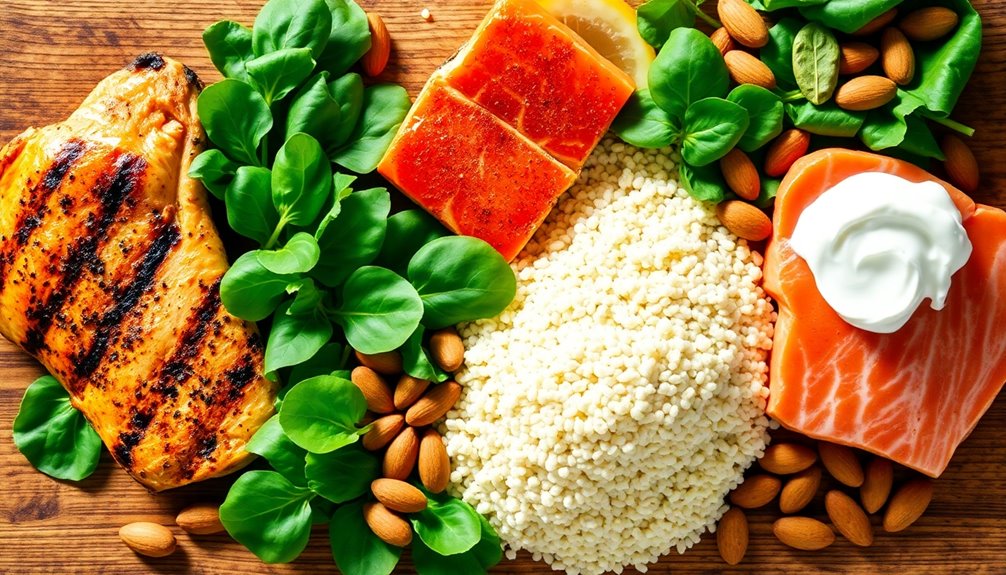
When it comes to understanding protein requirements, it's essential to know how much you need based on your body weight and activity level. The Recommended Dietary Allowance (RDA) suggests you consume 0.8 grams of protein per kilogram of body weight.
For instance, if you weigh 75 kg (165 lbs), you should aim for about 60 grams of protein daily. However, if you're an athlete or engage in intense exercise, your needs can jump to between 1.2 to 2.0 grams per kilogram to support muscle repair and growth.
To maintain a healthy weight while meeting your protein goals, focus on incorporating high-protein foods into your diet. Chicken breast, Greek yogurt, and lentils are excellent choices.
For instance, 100 grams of chicken breast provides 31 grams of protein, while Greek yogurt offers 10 grams per 100 grams.
Distributing your protein intake evenly across meals can enhance muscle protein synthesis and keep you feeling full. This means if you're targeting 180 grams of protein daily, a balanced approach to your meals will make reaching that goal easier and more enjoyable. Additionally, incorporating higher fat intake may help stabilize blood sugar levels, which is beneficial for optimizing overall health.
Protein Sources Overview
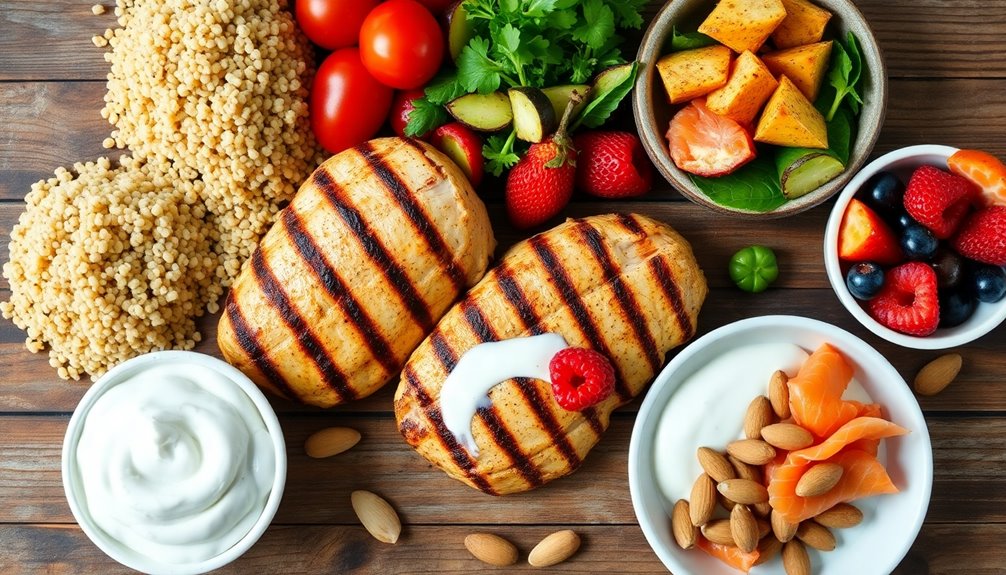
Protein sources are often abundant and varied, making it easy to meet your daily requirements. For efficient protein intake, grilled chicken breast is a top choice. A 150g serving offers around 31g of protein, which can greatly contribute to your daily goal. Additionally, proper hamster care can involve ensuring they receive balanced nutrition, similar to how we consider our own dietary needs. Essential oils can also support overall well-being, enhancing your health regimen. Research indicates that coffee's health benefits include antioxidants that can combat oxidative stress, which is vital for overall health.
If you're looking for quick and convenient options, canned tuna is excellent; a 100g serving delivers about 25g of protein.
Whey protein powder is another versatile option, with one scoop typically providing 20-25g. You can easily mix it into your smoothies or oatmeal for an added boost.
Greek yogurt is also a great choice—200g gives you around 20g of protein, perfect for snacks or breakfast.
Don't forget about legumes like lentils, which provide about 18g of protein per cooked cup, while also adding fiber to your meals.
For plant-based protein, consider incorporating chia seeds into your diet, as they not only offer protein but are also high in omega-3 fatty acids.
While you're planning your meals, remember that olive oil, high in unsaturated fat, can enhance the nutritional profile of your dishes without sacrificing taste. Additionally, incorporating foods rich in folate can further support your overall health and nutritional goals.
Breakfast High-Protein Ideas
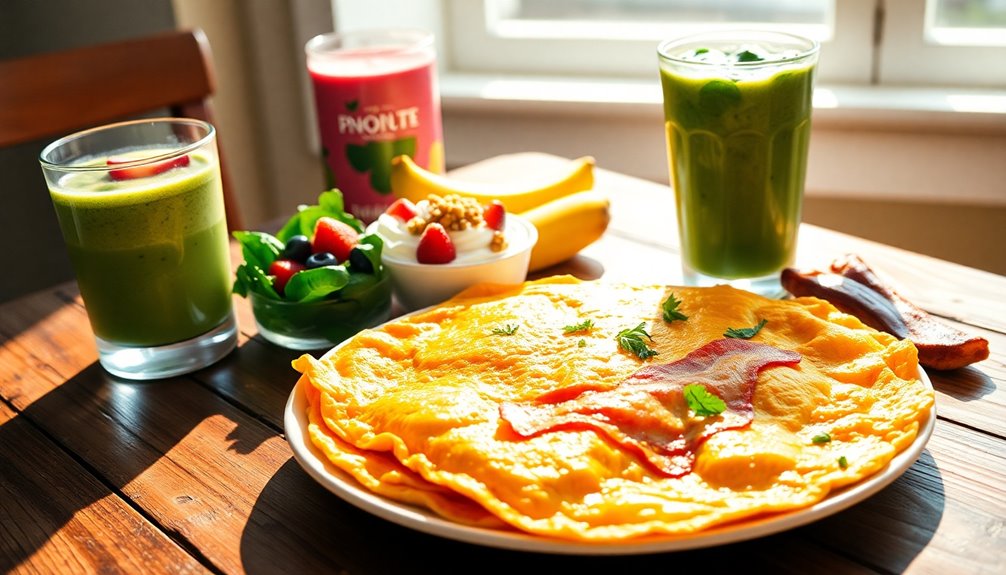
When you're looking to kickstart your day with high-protein breakfasts, quick options can make all the difference. Incorporating protein-rich ingredients like Greek yogurt or nut butter not only boosts your intake but also adds flavor. Additionally, including low carb foods can help you stay on track with your dietary goals. Furthermore, choosing eco-friendly materials for your kitchen utensils can enhance your cooking experience while being mindful of the environment. A great way to achieve this is by experimenting with high-protein recipes that can be prepared in advance. Additionally, consider including whole grains as they provide sustained energy alongside your protein-rich foods. Eating whole, unprocessed foods is essential for optimal health and can complement your high-protein breakfast plans while also promoting nutrient density.
Quick Breakfast Options
Banana Bread Oatmeal is an excellent choice, providing a whopping 48g of protein per serving. By incorporating Greek yogurt, you add an additional 10g of protein for just 60 calories. If you love smoothies, toss in a half scoop of vanilla casein protein powder to boost your intake while adding a creamy texture. Additionally, maintaining a balanced diet with adequate nutrition helps ensure that you meet your overall health needs. Consuming meal replacement juices can also support your protein goals while providing essential nutrients. Herbal teas can be a great addition to your morning routine, offering various health benefits to complement your protein-rich breakfast. It's also crucial to include essential fatty acids in your diet, as they play a significant role in maintaining hair health. Don't forget about chia seeds; they'll not only enhance protein levels but also keep you full longer. By prioritizing these high-protein breakfasts, you'll jumpstart your day with energy and nutrition! Including nutrient-dense choices can also support your overall health while keeping carbs low.
Protein-Rich Ingredients
To elevate your high-protein breakfast game, consider incorporating a variety of protein-rich ingredients that not only boost your intake but also enhance flavor and texture.
Here are some fantastic options to get you started:
- Greek Yogurt: A serving of 200g provides about 20g of protein, making it an excellent base for parfaits or smoothies. Additionally, yogurt can be enriched with essential oils like lavender to promote relaxation and well-being.
- Casein Protein Powder: Adding ½ scoop to your oatmeal increases its protein content by around 12g, while thickening the texture.
- Chia Seeds: Just 10g of these tiny seeds adds 2g of protein and a good dose of fiber, perfect for mixing into yogurt or smoothies. Additionally, chia seeds are a great plant-based source of omega-3 fatty acids, which are essential for heart health. Chia seeds also provide essential minerals like calcium and magnesium that support overall well-being.
- Oats: Using 50g in your breakfast recipe gives you an additional 6g of protein along with a filling base for toppings.
Incorporating these ingredients can also contribute to your overall health, much like the benefits of natural remedies that support immune function during cold seasons.
Meal Prep Tips
Meal prepping for high-protein breakfasts can transform your mornings and set a positive tone for the day ahead. Start by incorporating high-protein ingredients like Greek yogurt, casein protein powder, and skyr to easily reach around 30g of protein per meal. Additionally, consider including high-fat ingredients to enhance satiety and support your energy levels throughout the morning. Using educational construction toys can also be a fun way to engage your toddler while you prepare your meals. Regular consumption of high-protein foods may also improve your overall health and fitness levels.
For a delicious option, try making Banana Bread Oatmeal, which packs an impressive 48g of protein—ideal for boosting your daily intake with just one meal.
Overnight oats are another fantastic choice. Add protein sources like chia seeds and nuts for a nutritious, grab-and-go breakfast. You can also elevate your whole grain toast by topping it with nut butter or cottage cheese to enhance the protein profile.
Consider batch-preparing high-protein options like egg muffins or frittatas. These can be made ahead of time, allowing you quick access to protein throughout the week. Additionally, incorporating high-fiber vegetables can further enhance the nutritional value of your meals while supporting gut health.
Lunch Protein-Rich Recipes
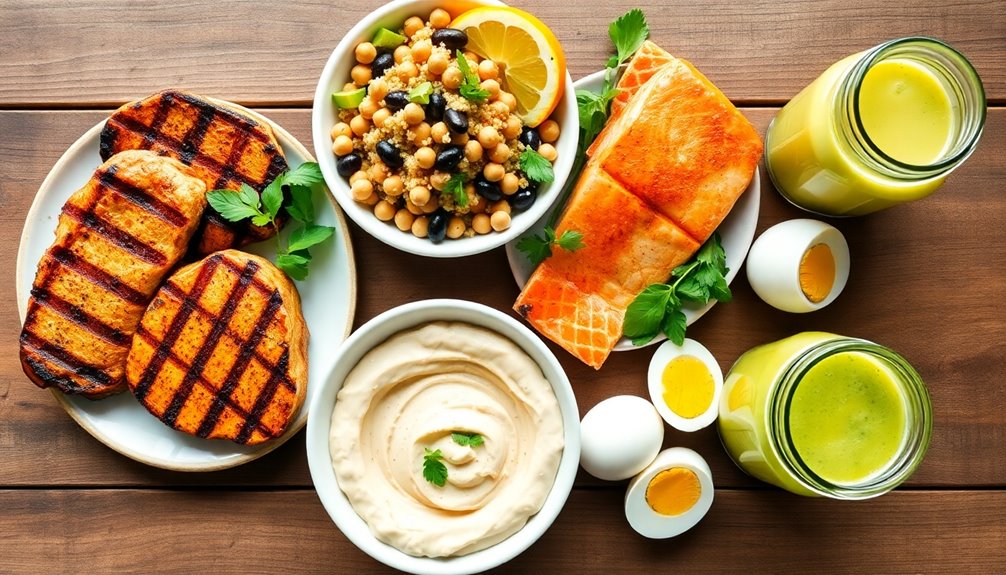
When it comes to lunch, you can pack in protein with quick meal prep ideas that don't skimp on flavor.
Think of options like a Caesar Salad with Grilled Chicken, which not only hits your protein goals but also keeps your meal balanced.
Let's explore some high-protein recipes that keep you energized and satisfied throughout the day. Engaging in interactive play can help enhance your overall cognitive and emotional well-being, making nutritious meals even more beneficial.
High-Protein Lunch Ideas
Looking to boost your protein intake at lunch? A high-protein meal can help you meet your daily goals while keeping you satisfied. One fantastic option is a Caesar Salad with Grilled Chicken, which packs a whopping 51g of protein per serving.
By using 160g of grilled chicken breast, you can enhance your nutritional profile without piling on extra calories. To keep your salad creamy and delicious, try a dressing made from light mayonnaise and skyr. It's low-calorie and complements the protein-rich ingredients perfectly.
Plus, adding Parmesan cheese not only elevates the flavor but also provides leucine, essential for muscle synthesis.
Here are some high-protein lunch ideas to contemplate:
- Caesar Salad with Grilled Chicken (51g protein)
- Quinoa and Black Bean Bowl (20g protein)
- Turkey and Avocado Wrap (30g protein)
- Greek Yogurt Parfait with Nuts (25g protein)
These options not only help you reach your protein targets but also keep your meals exciting and flavorful. Enjoy your lunch while fueling your body!
Quick Meal Preps
For those aiming to streamline their lunch prep while maximizing protein intake, quick meal preps are the answer. These recipes not only pack a protein punch but also keep your calorie count in check.
Here are three protein-rich lunch ideas you can whip up in no time:
| Recipe | Protein (g) |
|---|---|
| Caesar Salad with Grilled Chicken | 51 |
| Power Bowl with Greek Yogurt | 35 |
| Oven-Roasted Chicken and Potatoes | 52 |
The Caesar Salad with 160g of grilled chicken and a high-protein dressing made from light mayonnaise and skyr is a delicious option. You can also enjoy a Power Bowl featuring 300g of Greek yogurt, mixed with fruits and topped with walnuts or peanut butter for a tasty treat. If you're in the mood for something hearty, the Oven-Roasted Chicken and Potatoes dish, loaded with 220g of chicken thighs and veggies, will keep you satisfied.
Incorporating these meals into your lunch routine helps you stay on track to reach that 180g protein goal effortlessly!
Balanced Nutritional Choices
A variety of protein-rich lunch options can help you hit your daily nutritional goals while keeping your meals enjoyable. One great choice is a Caesar Salad with Grilled Chicken, which packs a whopping 51g of protein. By incorporating 160g of chicken breast, you'll get a significant protein boost essential for muscle repair and growth.
Plus, using light mayonnaise and skyr dressing keeps the calories lower while still adding flavor.
Here are some ideas to help you create balanced, protein-rich lunches:
- Caesar Salad with Grilled Chicken: 51g protein from chicken and 20g of Parmesan cheese for added leucine.
- Quinoa and Black Bean Bowl: Packed with plant-based protein and fiber.
- Turkey and Spinach Wrap: Lean turkey breast wrapped with fresh spinach for a nutritious bite.
- Tuna Salad with Greek Yogurt: A creamy, protein-packed alternative to traditional mayo.
Choosing meals like these helps you steadily approach your daily protein goal of 180g while maintaining a nutritious diet.
Enjoying a variety of options guarantees you stay satisfied and nourished throughout the day!
Snacks to Boost Protein Intake
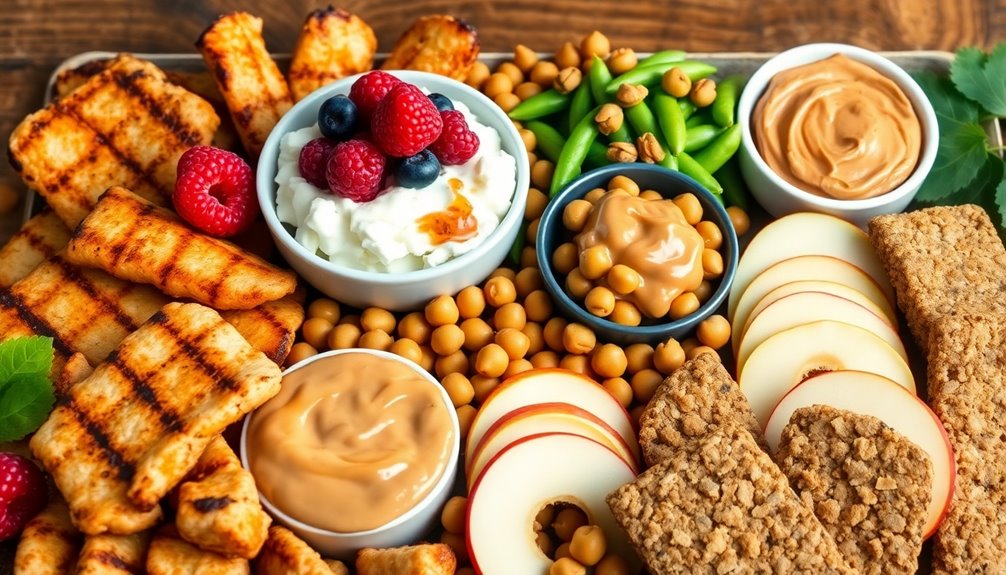
Snacks can be a delicious and effective way to boost your protein intake throughout the day. One of the simplest options is incorporating 300g of skyr or Greek yogurt into your snack. This can provide about 35g of protein, helping you hit your daily goals without much effort.
If you're looking for something crunchy, consider adding 20g of walnuts or peanut butter. Not only do they bring healthy fats to the table, but they also offer a nice protein boost. Pairing these with a sliced banana can enhance flavor and add essential nutrients while keeping your protein intake on track.
For a fruity touch, including 50g of blueberries and 100g of strawberries can elevate both taste and nutritional value without piling on calories.
You could also whip up a power bowl, designed to pack around 498 calories and 35g of protein, making it an ideal choice for those snack cravings.
Dinner Protein-Loaded Options
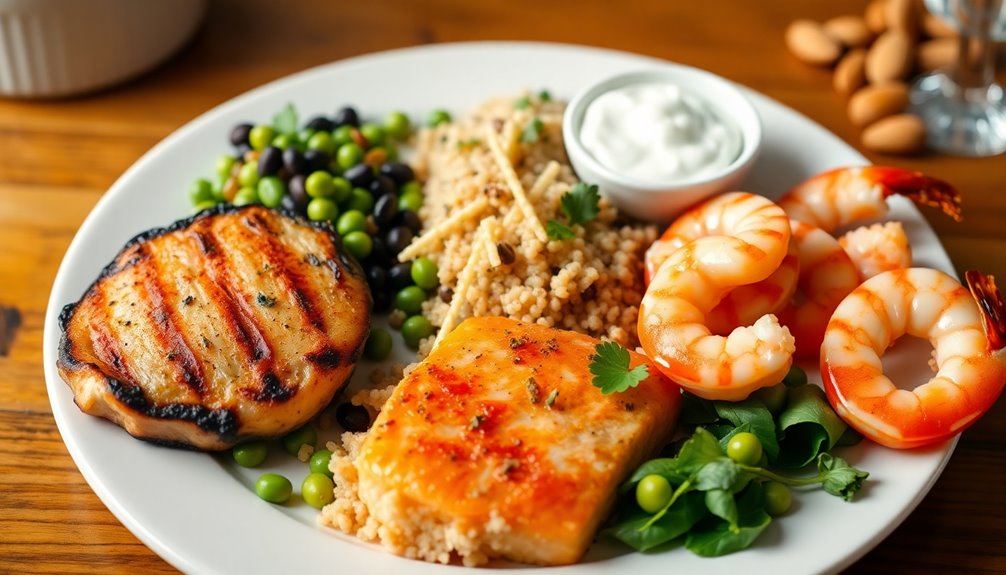
When it comes to dinner, you can elevate your protein intake with a variety of delicious options.
Incorporating protein-rich foods into your evening meals not only helps you reach your daily goals but also keeps your meals satisfying and nutritious.
Here are some tasty choices to evaluate:
- Oven-roasted chicken thighs (220g): Approximately 52g of protein.
- Grilled chicken breast in a Caesar salad (160g): Adds about 51g of protein.
- Grilled salmon (200g): Delivers around 40g of protein.
- Firm tofu (200g): Offers approximately 36g of protein, perfect for a vegetarian option.
Visualizing Portion Sizes
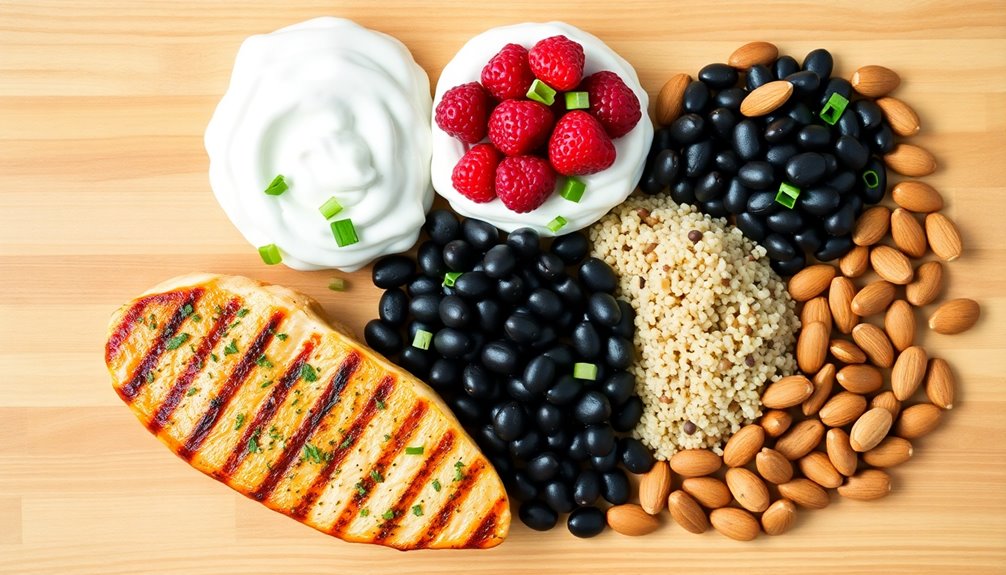
When you're planning your meals, understanding portion sizes can make a big difference in hitting that 180g protein goal.
By comparing serving sizes of various protein sources, you can easily strategize your meals for the day.
Let's explore how to maximize your intake with practical meal planning tips.
Protein Sources Overview
To effectively visualize how to reach 180g of protein, it's essential to understand the portion sizes of various protein sources. Knowing how much protein you can get from common foods helps you plan your meals better.
Here's a quick overview of some protein sources and their contributions:
- Chicken Breast (160g): ~51g of protein. You'd need about 3.5 servings to hit 180g.
- Greek Yogurt (240g): ~20g of protein. You'd need around 9 cups to reach your goal.
- Casein Protein Powder (50g): ~40g of protein. About 2.25 servings would help you achieve 180g.
- Tuna (150g): ~40g of protein. You'd need approximately 2.25 cans to meet the target.
Additionally, if you opt for lentils, 100g provides only about 9g of protein, meaning you'd have to consume around 2kg to reach 180g.
Serving Size Comparisons
Visualizing portion sizes helps you grasp how much protein you can realistically consume from different sources.
For instance, a standard chicken breast weighing about 160g packs around 51g of protein. To hit that 180g target, you'd need approximately 3.5 chicken breasts.
If you prefer Greek yogurt, a cup (240g) contains roughly 20g of protein, meaning you'd need about 9 cups to reach 180g.
On the other hand, skyr offers a lighter option; a 100g serving provides around 10g of protein, so you'd need 18 servings to meet your goal.
If eggs are your choice, one large egg contains about 6g of protein, so you'd be looking at consuming around 30 eggs to get to 180g.
Lastly, if you're using protein powder, a typical 30g serving gives you around 20g of protein. This means you'd need about 9 servings to hit that 180g mark.
Understanding these serving sizes can make it easier for you to plan your protein intake effectively.
Meal Planning Strategies
Planning your meals around protein-rich ingredients makes hitting that 180g target much easier. By strategically incorporating meals throughout your day, you can visualize your intake more effectively and guarantee you're getting enough protein.
Here's a simple meal plan to help you reach that goal:
- Breakfast: Start with a Breakfast Banana Bread Oatmeal (48g protein).
- Lunch: Enjoy a Caesar Salad with Grilled Chicken (51g protein).
- Snack: Opt for a Power Bowl, which adds another 35g of protein.
- Dinner: Finish your day with an Oven-Roasted Chicken and Potatoes meal (52g protein).
To boost your protein intake further, consider using skyr or Greek yogurt as a base for multiple meals. They provide about 10g of protein per 60 calories, making them a low-calorie option to enhance your meals.
Planning meals with protein-rich foods like chicken, Greek yogurt, and protein powders allows for easy tracking and visualization of your protein intake throughout the day.
Combining Protein Sources
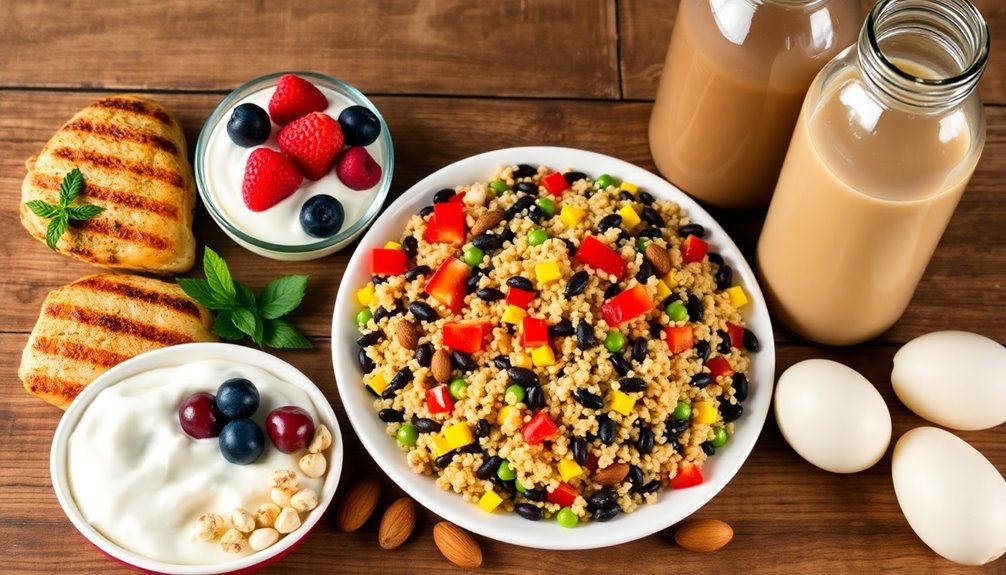
Often, combining different protein sources can help you reach your daily goal of 180g more effectively. For instance, you could start your day with a hearty serving of Banana Bread Oatmeal, which packs about 48g of protein. For lunch, a Caesar Salad with Grilled Chicken will contribute an additional 51g. Snacking on a Power Bowl can add 35g, and finishing your day with Oven-Roasted Chicken and Potatoes gives you another 52g, totaling around 186g of protein.
Incorporating protein-dense foods like Greek yogurt or chicken breast can further boost your intake. For example, a scoop of Greek yogurt provides 10g of protein per 60 calories, while 100g of chicken breast delivers about 31g.
Consider adding protein powders, such as casein or whey, to your meals; half a scoop of casein adds roughly 12g of protein.
Don't forget about nuts and seeds—20g of walnuts adds about 4g of protein and healthy fats. By diversifying your protein sources through dairy, poultry, legumes, and supplements, you guarantee a balanced intake of essential amino acids, vital for muscle repair and growth.
Tracking Your Intake
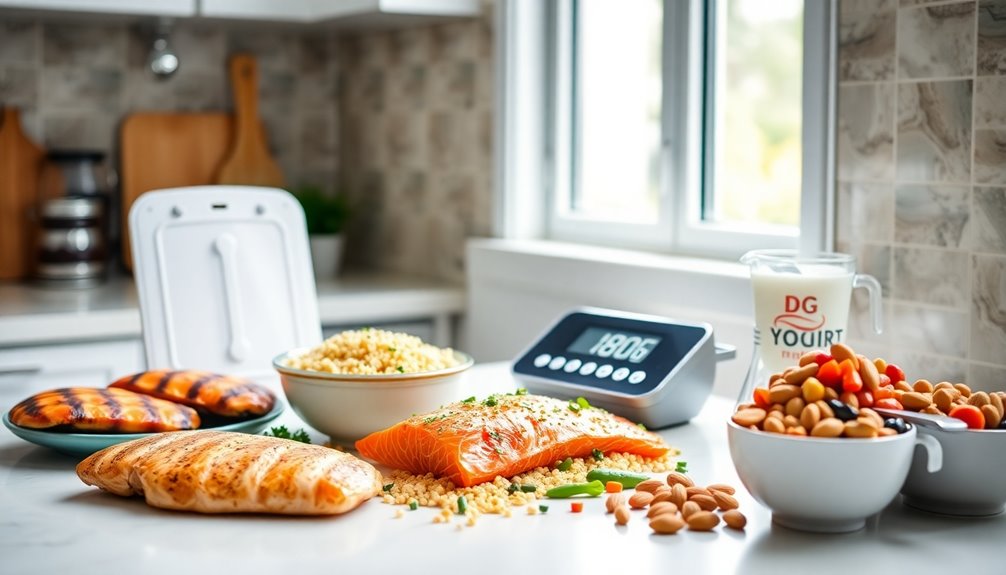
Effectively tracking your protein intake is essential for reaching your goal of 180g daily. By measuring the protein content in each meal, you can guarantee you're hitting your target.
Try to incorporate various high-protein foods throughout your day. Here are some strategies to help you track your intake:
- Use food labels and nutritional databases to quantify protein in different foods.
- Consider staples like chicken breast, which offers about 51g of protein per 160g serving.
- Include high-protein snacks, such as a power bowl with 300g of Greek yogurt, contributing around 35g.
- Keep a food diary or use tracking apps to monitor your daily protein consumption.
Tips for Meeting Goals
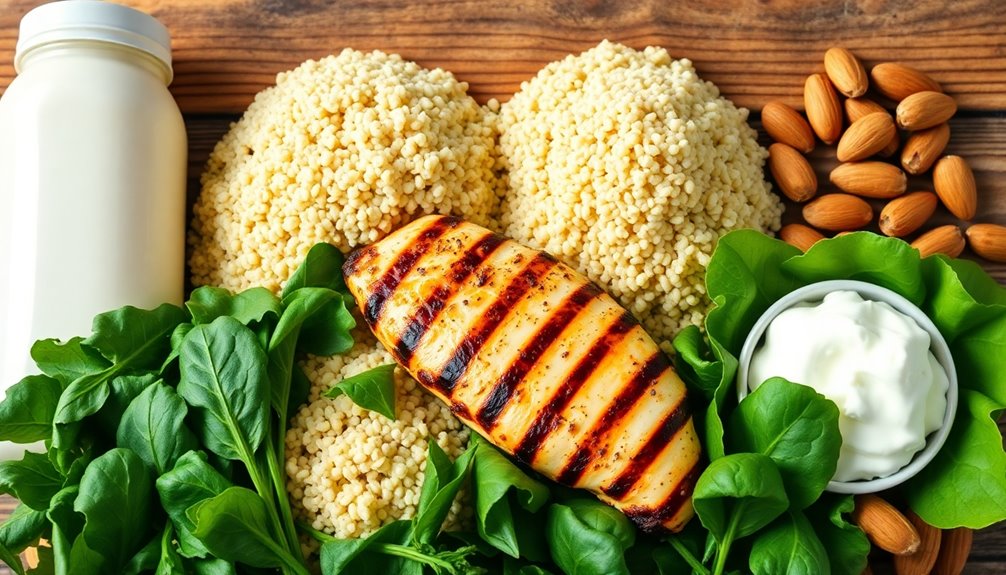
How can you consistently hit your protein goals while enjoying a variety of meals? Start by incorporating high-protein foods like chicken breast and Greek yogurt into your diet. For instance, 160g of chicken breast provides around 51g of protein, while 300g of Greek yogurt adds about 30g.
Don't forget about protein-rich snacks! A Power Bowl made with skyr and fruits can give you around 35g of protein per serving.
For breakfast, try Banana Bread Oatmeal; when you add casein protein powder and Greek yogurt, you can get about 48g of protein.
At lunch, a Caesar Salad with Grilled Chicken can also help you reach your goals, offering approximately 51g of protein with the right mix of ingredients.
Finally, tracking your protein intake using a food diary or app is vital. This approach not only helps you guarantee you meet your 180g goal but also helps maintain a balanced diet.
Frequently Asked Questions
What Does 180 Grams of Protein a Day Look Like?
When you aim for 180 grams of protein a day, it helps to plan your meals wisely.
For instance, you can enjoy two servings of chicken breast for 104 grams, add a 300g serving of Greek yogurt for another 35 grams, and include a protein shake for 15 grams.
Incorporating snacks like skyr with walnuts can boost your intake by another 35 grams, making it easier to hit that protein goal without feeling stuffed.
Is 180G of Protein a Day Too Much?
Imagine filling your plate with lean meats, beans, and protein shakes, all to reach that hefty 180 grams of protein.
For some, especially those heavily into strength training, it can be beneficial. However, for most people, that amount's excessive.
You risk kidney strain and other health issues, especially if you don't have specific dietary needs.
It's wise to consult a healthcare professional to find the right balance for your body.
What Does 200G of Protein Look Like?
To hit 200g of protein, you'll want to combine various sources throughout your day.
For breakfast, you could mix 50g of oats with protein powder and Greek yogurt.
Lunch might include grilled chicken and Parmesan cheese, while dinner could feature oven-roasted chicken thighs.
Don't forget snacks, like mixed nuts, to boost your intake.
Is 2 Eggs a Day Enough Protein?
Is two eggs a day really enough protein?
While those eggs pack about 12 grams of protein, they barely scratch the surface of your daily needs, especially if you're aiming for 180 grams.
To truly fuel your body, you'll need to incorporate more protein-rich foods like lean meats, dairy, or legumes.
Eggs are great, but they shouldn't be your only source if you want to support muscle growth and overall health.
Conclusion
So, you thought hitting 180 grams of protein was like devouring a mountain of chicken breast? Surprise! It's more about clever combinations and sneaky snacks. Picture a breakfast burrito stuffed with eggs and beans, a hearty quinoa salad for lunch, and a handful of almonds when cravings strike. You're not wrestling a giant steak; you're assembling a delicious jigsaw puzzle of diverse foods. With a little creativity, you'll meet your protein goals without turning mealtime into a meat fest!
